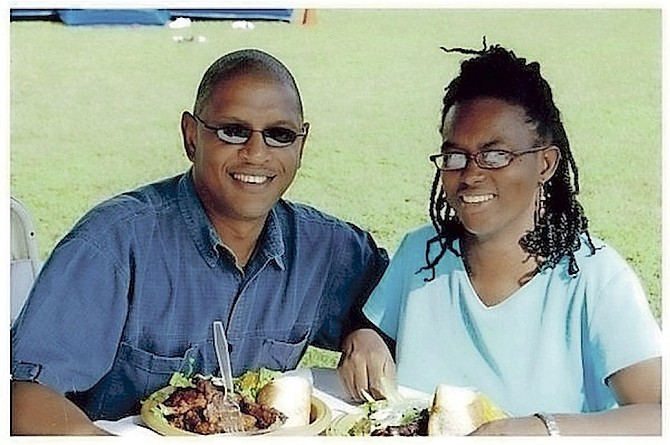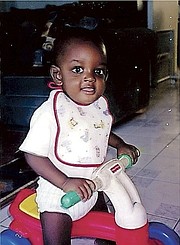When Kevin and Valarie Seymour read last week about the battles of baby Aidan Roger Carron against a little known life-threatening disease, it brought back memories of their son. This is a father’s moving account of losing their ‘promised child’.
AS I came through the door from work last week, my wife Valarie handed me The Tribune and directed me to the front page article entitled “From a Picture of Health to Death’s Door for Baby Aidan”.
The article told the story of Elizabeth and Robert Dupuch Carron and their infant son, Aidan, who developed Haemophagocytic Lymphohistiocytosis (HLH) and almost died.
The article mentioned that “like many Bahamians” the Carrons had never heard of HLH. As it so happens, my wife and I were among the few Bahamians who had intimate knowledge of this disease.
Our son Kyle developed a related strain of Histiocytosis called Langerhans Cell Histiocytosis (LCH). As I read, my heart went out to the Carrons as they related their experiences with doctors at a loss for a diagnosis, PICC lines, biopsies, chemotherapy and falling platelet counts. Every story mirrored our own, but for three exceptions:
First, our son had LCH and not HLH (although the effects were the same);
Second, our son’s disease progressed slowly and more insidiously so by the time he was diagnosed, much damage had been done;
And third, our son lost his fight with this disease.
Kyle died on November 26, 2002, at 19 months old after three months at Miami Children’s Hospital (MCH) and Children’s Hospital in Chicago. Several years after Kyle’s death, I wrote the following on a memorial message board to help me sort out the loss I was feeling. I hadn’t looked at the piece in over 10 years, but, with minor edits and updates I reproduce it here:
“My son, Kyle Ethan Seymour, was my fourth child after three daughters, and although I love my girls (including my latest daughter, bringing the total to four), I have to admit that I had been waiting for my son for a long time. I’d had his name picked out 20 years before he was born. I was ready for when he finally showed up. It was vain and chauvinistic, I know, but I believe something in most men wants that chance to pass on his name.
Kyle was with us for 19 months. For most of that time my wife and I made plans for him, loved him and cared for him.
We had noticed a chronic scalp rash (which we took for ringworm) and Kyle was never a big eater. But we weren’t worried. He learned to walk, sit up and climb. Then, at 15 months, he developed jaundice, lost weight and stopped walking.
We took him to several doctors without getting a diagnosis, before one prescribed a blood profile (a MAC 25, I think) and saw that his blood chemistry was all over the place. His paediatrician still had no idea what was wrong, but he recommended we fly him to MCH.
We flew there immediately - concerned, but confident and congratulating ourselves that we had the foresight, diligence and resources to make this short trip to heal our son.
After 10 days and a battery of tests at MCH, the doctor gave us the news. Our son had LCH, a rare blood disease, similar to leukaemia in that there is an uncontrolled growth of histiocytes (a type of white blood cell used in the auto-immune system), except the cells are not malignant.
Kyle’s histiocytes were growing uncontrollably and were attacking healthy cells in his skin and then his liver. My son was being attacked by his own body. Nevertheless, the doctors at MCH assured us that the prognosis was good. Though rare, MCH staff saw three or four cases per year and could treat it with chemotherapy.
We made more plans for my wife to remain with our son, with me rotating in from time-to-time to give her a break and come home. We checked our son into the paediatric ward with the other sick children. I remembered feeling sorry for the other patients on the ward, most of whom had cancer or some other deadly disease, and thinking how glad I was that our son wasn’t so afflicted.
For three and a half months we fell into a routine. I would fly over every two weeks to see my wife and son. Every second visit, my wife would fly home, while I remained. Our son went through biopsies and tests and chemotherapy. He got an implant to allow easier administration of drugs ... and meanwhile his liver and his skin grew worse.
In November, 2002, after three and a half months, we brought Kyle home for three days (the first time since he was admitted and the last time in his life). I flew back to Miami after the short stay to continue his treatment and the doctors gave me the news. Our son was not responding to treatment and his liver was deteriorating. They wanted to transfer him to Children’s Hospital in Chicago - an institution that specialised in liver transplants. For the first time, the likelihood that our son might die was raised. We had been praying for his healing throughout his hospitalisation.
We flew Kyle to Chicago on an air ambulance and arrived on a cold, grey November afternoon and checked into Children’s Hospital. As before, we planned for the healing of our son. We met with doctor after doctor before one levelled with us ... our son was not responding to treatment because his damaged liver limited the chemo dosages, but he could not be considered for a liver transplant until his disease was under control. I asked the Attending Physician if my son was going to die. She looked at me, not unkindly, but with a professional detachment and answered “yes”.
Returning home, I made plans to return in two weeks while my wife remained in Chicago at our son’s side. One week later, my wife called for me to return right away. It was Monday afternoon. I pulled our then four-year-old daughter out of school and rushed to the airport.
We ran from plane to plane to make our connections and arrived in Chicago shortly after midnight. We went straight to the hospital where my wife was in intensive care with our now intubated son.
He was still alive, but his liver and kidneys had failed. He was bleeding from everywhere. His skin was peppered with dark spots from his blood that no longer clotted due to lack of platelets. His bones were brittle from the chemotherapy - so much so that his arm had been broken. We didn’t even know.
The doctors had induced a coma to relieve his pain. He had had a cardiac arrest earlier that day but had been revived. When I arrived in ICU, my wife had already instructed the nurses to clean him up so I would be spared the sight. She had used all of her considerable emotional strength to do that and I could see that she had withdrawn and resigned herself to losing him. Still ... I could not let him go. Not yet.
Later that morning the hospital called to tell me my son had had another cardiac episode and asked me to come down. My wife stayed away.
There, in the ICU, I said goodbye to my son and authorised the hospital not to revive him if his heart stopped again and left to wait.
At 2.20pm, Kyle Ethan Seymour died. For most of his illness we were so sure he would be healed.
Everything we learned about LCH suggested that it was not normally fatal. We searched for reasons, meaning or a purpose for this loss. As other parents who have gone through this know, we could find none.
It has been five years since our loss. We now have another son, Ethan Kevin Seymour, born August, 2004. Ethan looks just like his namesake, Kyle Ethan, and we watch for every rash, every cough, every fever. When Ethan was 19 months old, I couldn’t stop crying ...”
As it so happens, Ethan was diagnosed with an Autism Spectrum Disorder. He is language delayed and has other challenges that sometimes make him a handful.
Nevertheless, we are thankful for him and the fact that he is generally in good health. We learned in 2002 that good health is to be cherished and, over the years, we also learned that the passage of time soothes (but doesn’t actually heal) the worst of losses.
In reading that article about little Aidan, I felt connected to the Carrons – so much so that I was genuinely able to feel joy and relief that Aidan won his fight against this disease. I thank God for His deliverance and healing through what I know was an ordeal for both Aidan and his parents.
• Do you have a medical story to tell? Email your tale to ishare@tribunemedia.net






Comments
Use the comment form below to begin a discussion about this content.
Sign in to comment
Or login with:
OpenID